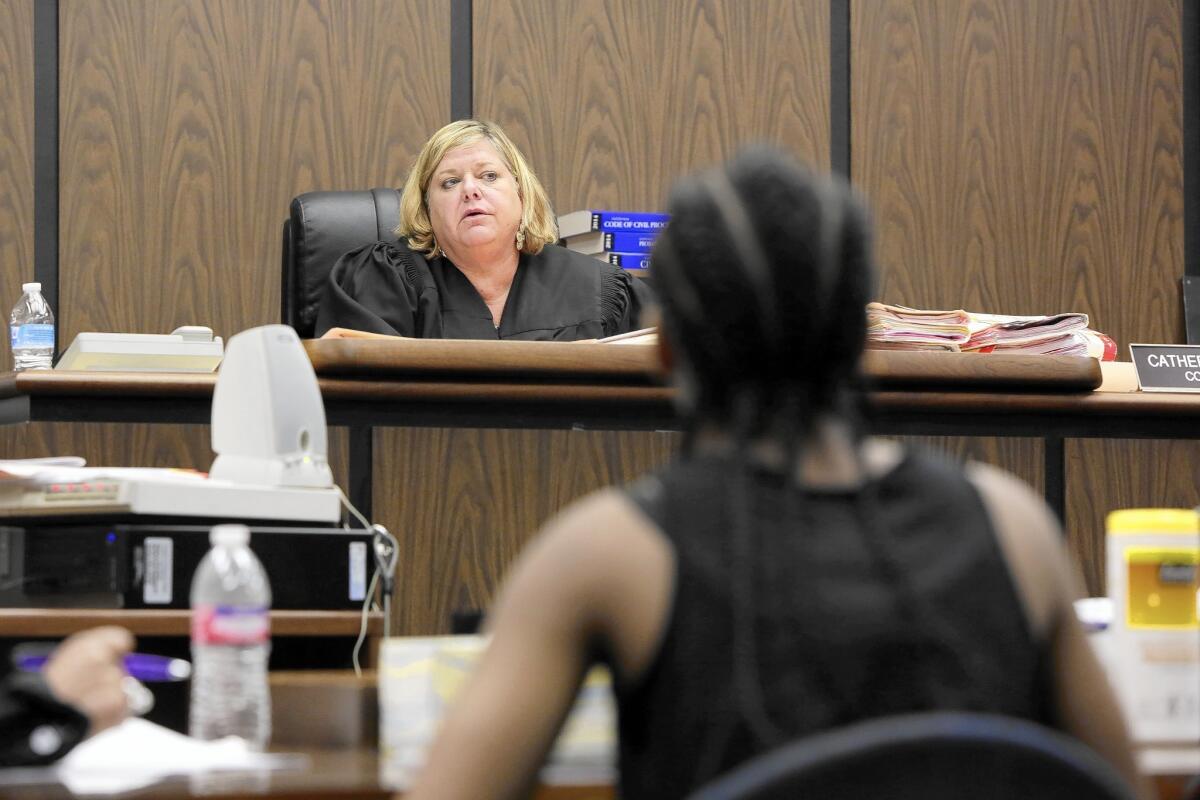L.A. County reaching out to save children from prostitution

The teenage girl slouched in her baggy orange detention uniform for yet another court hearing in her prostitution case.
From the bench, Commissioner Catherine Pratt called out a sunny “hello,” trying to create a human bond for a girl who has few of them.
“You’re beginning to look pregnant,” Pratt said. “Before, I didn’t even notice.”
The girl told the commissioner that she felt trapped at juvenile hall, worrying by day that she would give birth behind bars, dreaming at night of Nutella and hot Cheetos.
“They don’t even give me any sugar,” she said. “It ain’t right.”
Pratt told the girl that if she would stop running back to the streets, Pratt would place her in a group home where she could eat what she wants, keep her child out of foster care and hold the baby shower she fantasizes about.
“You’ll have to let me know when it is. I’d like to go,” Pratt said, prompting a startled chuckle from the girl. “You’re not doing this alone. We’re going to help you.”
The humble, affirming approach of Pratt’s Compton courtroom began as an experiment three years ago, when she applied for grant money to provide professional help for the young prostitutes and she set aside Tuesdays to focus exclusively on sex trafficking cases.
Advocates from at least three charities providing mentors, educational liaisons and lawyers sit in the jury box of Pratt’s courtroom to connect with youths as soon as the need arises.
Los Angeles County supervisors launched a plan this year that adopts Pratt’s ethos, and social workers, police officers and others are being trained to take a softer approach to the children involved in prostitution. They are instructed to treat these young prostitutes as victims rather than perpetrators.
Police officers are receiving training in many parts of the county to call the child abuse hotline when they find children engaged in prostitution instead of booking them for a crime. County officials expect that hundreds of youths will be diverted from juvenile detention facilities in favor of foster care placements.
“I used to lecture them,” Pratt said. “ ‘You’re making bad choices. This is dangerous.’ I tried to explain to them how short the life span for people in prostitution is. And they were not at all interested. It really didn’t resonate with them at all.”
A personal relationship and trust have to be developed first, she said, and she measures her progress in the pictures, emails and poems that some of the youths send her.
Still, there is risk.
More than 60% of Los Angeles County’s children arrested for prostitution had previously come to the attention of the county’s Department of Children and Family Services, and the foster care system’s group homes have become one of most frequent gateways to the sex trade because the children there have fewer family ties and pimps target them for recruitment.
But the foster care system is currently the county’s only alternative to juvenile detention facilities.
“It’s like we’re building a bridge and trying to walk across it at the same time,” said Fesia Davenport, the chief deputy director of the Department of Children and Family Services.
Adding urgency to the work is the belief that criminal gangs are increasingly turning to the lucrative human trafficking trade. A drug is sold once, but a child is sold over and over, advocates note.
Pratt, a former attorney for Wall Street firms, was drawn to public service years ago after her sister was killed when she stayed in an abusive relationship.
Pratt initially became involved in the battered women’s movement, advocating for increased services to victims of rape and domestic violence, and harsher punishment for abusers.
After leaving private practice, she became an attorney for the county, petitioning the court to remove children from abusive parents, and she was later appointed a court commissioner, deciding juvenile delinquency cases. When children involved in prostitution arrived in her courtroom, she recognized parallels to her sister.
“These kids come from a rough background and also made some bad choices, but I really believe that you should have the opportunity to live down your bad choices,” Pratt said.
Since her experimental courtroom began in 2011, the average number of days a child spends in juvenile detention has dropped from 35 days to 20 days, 73% of the children have not been rearrested and 22% remained in contact with a member of Pratt’s support team even after the case was closed and they were no longer obligated to maintain touch.
But getting the children to achieve stability in a single foster care setting and off the streets has been less successful. The data don’t show any movement on that goal.
“I wouldn’t say it has been a roaring success,” Pratt said, “but for the first time in this area, people feel like there is some hope, and it can often look really hopeless.”
Survivors of child sex trafficking are conflicted: They are gratified that the issue is receiving attention through television talk shows, campus marches and politicians, but they worry about whether the county’s new efforts will help.
Amy Ayoub, who became a successful businesswoman after growing up being sexually exploited by a pimp, was recently appointed by Congress to a commission to eliminate child abuse fatalities.
“I believe that there are a lot of well-intentioned people, but I am absolutely frightened that this can do more harm than good,” Ayoub said. “It seems like they are looking at existing agencies and processes to deal with this instead of taking a step back and looking at the victims and the needs and saying we need to come up with something new.”
County officials share her trepidation but decided to go forward nevertheless. Early last year, the Board of Supervisors ordered staffers to draft a plan to identify and help children involved in prostitution. But the county blueprint was recently delivered more than five months late with key questions unresolved.
The county spent months trying to determine whether foster children can be legally sent to locked facilities to prevent them from returning to their pimps before treatment begins. County lawyers finally concluded that current law would not allow it unless they are charged with a crime.
County officials are now debating whether to ask Sacramento lawmakers to change the law.
“I don’t think locked facilities are the answer for most of our kids, but it might be helpful to have it as an option in some cases,” Davenport said.
Complicating the work further was a determination that there are no treatment methods with evidence of success.
Pratt oversees the cases of 102 children who have been involved in prostitution, and she said she tries to develop individualized plans for each. About a third are in juvenile detention facilities; another third are in foster care; and the rest have run away, she said.
For some children, the commissioner said, the county has learned that a foster care placement out of state works best to break the bond with pimps — but cooperation from the child is a key.
“When we first used the out-of-state group homes, we did not have the buy-in of the kids. They can run from a facility in Iowa just as easily as they can run from a facility in Los Angeles,” she said.
The move away from incarceration has critics who believe children will use the freedom of unlocked facilities to spend more time on the streets.
A woman from Culver City adopted her daughter through foster care only to see her arrested numerous times for prostitution. The woman, whose name is not being used because it might identify the 17-year-old, said she reluctantly preferred it when the girl was sent to juvenile hall because she knew she was safe from harm.
But Pratt sent the daughter to foster care placements, and she quickly ran back to the streets.
Another mother, a Los Angeles bus driver, has a daughter who was arrested for prostitution. The daughter sometimes runs away from the group homes where Pratt assigns her, but she is returning more quickly.
The girl told the court that she disappeared for two days recently because another girl “jumped her” and threw trash at her.
Pratt praised the girl for calling authorities soon after her disappearance. “That’s a good choice. I’m glad you did that,” she said.
“Do you feel like you need to get out of the group home right away?” Pratt asked. “I want to support you.”
The girl, knowing that the only other immediate option was juvenile hall, agreed to return to the group home.
In the hallway outside the courtroom, her mother praised Pratt’s approach.
“She is very open-minded to whatever you bring and present to her,” she said. “Ms. Pratt has given me other avenues to assist her, other parents to talk to. It has been helpful.”
Weeks later, Pratt said the pregnant girl at juvenile hall had just gone to a group home. Pratt hadn’t received any word about whether she ran away again or if she was planning a baby shower. Doubt crept into her voice when she said, “We’re hoping for good news.”
Follow @gtherolf for breaking news about the foster care system.
More to Read
Sign up for Essential California
The most important California stories and recommendations in your inbox every morning.
You may occasionally receive promotional content from the Los Angeles Times.











